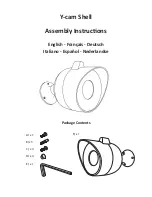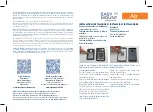
D-81
E2Q4
E2Q
4
Connection
DC type
Precautions
Power supply
Do not impose an exessive voltage on the E2Q2, otherwise it
may explode or burn.
Do not connect an AC power supply to any DC model. If AC
power (100 VAC or more) is supplied to the sensor, it may ex-
plode or burn.
Be sure to abide by the following precautions for the safe op-
eration of the Sensor.
Wiring
Power Supply Voltage and Output Load Power Supply Volt-
age
Make sure that the power supply to the Sensor is within the
rated voltage range. If a voltage exceeding the rated voltage
range is supplied to the Sensor, it may explode or burn.
Load Short-circuiting
Do not short-circuit the load, otherwise the Sensor may be
damaged.
Connection without Load
Do not connect the power supply to the Sensor with no load
connected, otherwise the internal elements may explode or
burn.
Operating Environment
Do not use the Sensor in locations with explosive or flamma-
ble gas.
Design
Effects of Surrounding Metal
Provide a minimum distance between the Sensor and the sur-
rounding metal as shown in the table below.
Mutual Interference
If more than one Sensor is located in parallel, ensure to main-
tain enough space between adjacent Sensors to suppress
mutual interference as provided in the following diagram.
Connection type
Method
Description
AND
(serial connection)
The Sensors connected together must satisfy the following conditions:
i
L
+ (N-1) x i
≤
Upper-limit of control output of each Sensor
V
S
- N x V
R
≥
Load operating voltage
N = No. of Sensors
V
R
= Residual voltage of each Sensor
V
S
= Supply voltage
i
= Current consumption of the Sensor
i
L
= Load current
If the MY Relay, which operate at 24 VDC, is used as a load for example,
a maximum of two Proximity Sensors can be connected to the load.
OR
(parallel connec-
tion)
A minimum of three Sensors with current outputs can be connected in
parallel. The number of Sensors connected in parallel varies with the
Proximity Sensor model.
!
Caution
Correct Use
Effects of Surrounding Metal (Unit: mm)
Model
Length
A
B
C
E2Q4-N20
##
-M1
45
0
0
E2Q4-N30M
##
-M1
90
250
30
E2Q4-N40M
##
- M1
120
300
40
Mutual Interference (Unit: mm)
Model
Length
A
E2Q4-N20
##
-M1
40
E2Q4-N30M
##
-M1
120
A
B
C
A
Side-by-side
F502-EN2-04.book Seite 81 Dienstag, 26. Juli 2005 5:48 17
























